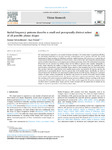Radial frequency patterns describe a small and perceptually distinct subset of all possible planar shapes
| dc.contributor.author | KANG, JUNGHEE | |
| dc.contributor.author | Fruend, I | |
| dc.date.accessioned | 2018-12-05T14:19:41Z | |
| dc.date.issued | 2019-01 | |
| dc.identifier.issn | 0042-6989 | |
| dc.identifier.issn | 1878-5646 | |
| dc.identifier.uri | http://hdl.handle.net/10026.1/12991 | |
| dc.description.abstract |
The visual system is exposed to a vast number of shapes and objects. Yet, human object recognition is effortless, fast and largely independent of naturally occurring transformations such as position and scale. The precise mechanisms of shape encoding are still largely unknown. Radial frequency (RF) patterns are a special class of closed contours defined by modulation of a circle's radius. These patterns have been frequently and successfully used as stimuli in vision science to investigate aspects of shape processing. Given their mathematical properties, RF patterns can not represent any arbitrary shape, but the ability to generate more complex, biologically relevant, shapes depicting the outlines of objects such as fruits or human heads raises the possibility that RF patterns span a representative subset of possible shapes. However, this assumption has not been tested before. Here we show that only a small fraction of all possible shapes can be represented by RF patterns and that this small fraction is perceptually distinct from the general class of all possible shapes. Specifically, we derive a general measure for the distance of a given shape's outline from the set of RF patterns, allowing us to scan large numbers of object outlines automatically. We find that only between 1% and 6% of naturally smooth outlines can be exactly represented by RF patterns. We present results from a visual search experiment, which revealed that searching an RF pattern among non-radial frequency patterns is efficient, whereas searching an RF pattern among other RF patterns is inefficient (and vice versa). These results suggest that RF patterns represent only a restricted subset of possible planar shapes and that results obtained with this special class of stimuli can not simply be expected to generalise to any arbitrary planar shape. | |
| dc.format.extent | 122-130 | |
| dc.format.medium | Print-Electronic | |
| dc.language | en | |
| dc.language.iso | en | |
| dc.publisher | Elsevier | |
| dc.subject | Radial frequency patterns | |
| dc.subject | Visual search | |
| dc.subject | Planar shape | |
| dc.subject | Shape | |
| dc.subject | Efficient search | |
| dc.title | Radial frequency patterns describe a small and perceptually distinct subset of all possible planar shapes | |
| dc.type | journal-article | |
| dc.type | Journal Article | |
| dc.type | Research Support, Non-U.S. Gov't | |
| plymouth.author-url | https://www.webofscience.com/api/gateway?GWVersion=2&SrcApp=PARTNER_APP&SrcAuth=LinksAMR&KeyUT=WOS:000455859400012&DestLinkType=FullRecord&DestApp=ALL_WOS&UsrCustomerID=11bb513d99f797142bcfeffcc58ea008 | |
| plymouth.volume | 154 | |
| plymouth.publication-status | Published | |
| plymouth.journal | Vision Research | |
| dc.identifier.doi | 10.1016/j.visres.2018.10.007 | |
| plymouth.organisational-group | /Plymouth | |
| plymouth.organisational-group | /Plymouth/Faculty of Health | |
| plymouth.organisational-group | /Plymouth/Faculty of Health/School of Health Professions | |
| plymouth.organisational-group | /Plymouth/REF 2021 Researchers by UoA | |
| plymouth.organisational-group | /Plymouth/REF 2021 Researchers by UoA/UoA03 Allied Health Professions, Dentistry, Nursing and Pharmacy | |
| plymouth.organisational-group | /Plymouth/Research Groups | |
| plymouth.organisational-group | /Plymouth/Research Groups/Institute of Health and Community | |
| plymouth.organisational-group | /Plymouth/Users by role | |
| plymouth.organisational-group | /Plymouth/Users by role/Academics | |
| dc.publisher.place | England | |
| dcterms.dateAccepted | 2018-10-25 | |
| dc.rights.embargodate | 2019-12-5 | |
| dc.identifier.eissn | 1878-5646 | |
| dc.rights.embargoperiod | Not known | |
| rioxxterms.versionofrecord | 10.1016/j.visres.2018.10.007 | |
| rioxxterms.licenseref.uri | http://www.rioxx.net/licenses/all-rights-reserved | |
| rioxxterms.licenseref.startdate | 2019-01 | |
| rioxxterms.type | Journal Article/Review |


